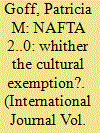| Srl | Item |
| 1 |
ID:
159604


|
|
|
|
|
| Summary/Abstract |
Twenty-five years ago, as preferential trade agreements started to proliferate, Jagdish Bhagwati sounded the ‘spaghetti bowl’ alarm, arguing that the ensuing complexity would create inefficiencies in the international system and challenges for firms navigating overlapping rules. This article seeks to update and complement Bhagwati’s thesis by asking if proliferating ‘deep’ trade agreements add a new dimension of complexity to this picture. This article shows that the early answer to this question is ‘not yet’, as governments have discovered that prospective conflicts with existing or simultaneous commitments limit just how deep the provisions of an agreement can be. Governments managing multiple deep agreements play a variation on Putnam’s two-level game. As Putnam theorized, these governments reconcile domestic interests with international opportunities in formulating their strategies. However, ensuring compatibility across various, sometimes competing international opportunities is also a key consideration. Canada’s concurrent participation in the Trans-Pacific Partnership (TPP) and the Canada–European Union Comprehensive Economic and Trade Agreement (CETA) provides a crucial exploratory case study.
|
|
|
|
|
|
|
|
|
|
|
|
|
|
|
|
| 2 |
ID:
157683


|
|
|
|
|
| Summary/Abstract |
The North American Free Trade Agreement renegotiation has created uncertainty around a number of provisions, including the cultural exemption. I argue that Canadian government advocacy of a cultural exemption will take place in a new context due to the approaches they have favoured in recent trade agreement negotiations, and to economic shifts driven by digital technologies.
|
|
|
|
|
|
|
|
|
|
|
|
|
|
|
|
| 3 |
ID:
141727


|
|
|
|
|
| Summary/Abstract |
Innovative mechanisms of global governance are increasingly common, yet they defy easy categorization. The Alliance of Civilizations, a UN initiative that seeks to promote intercultural dialogue, is one such example. It is a hybrid entity that exhibits elements of networks, international organizations, and public–private partnerships, among other things. Only when we shift our gaze to its patterned activities do we discover that it might best be understood as a community of practice specializing in global-level public diplomacy. Practice-based analysis, therefore, allows a deeper understanding of the Alliance and, in turn, prompts a fresh consideration of an increasingly important form of diplomacy. I argue, in particular, that public diplomacy is not solely a national-level, state-oriented activity. In turn, this inquiry invites practice theorists to reflect on the degree of fit required to associate a unique social form with an identifiable set of patterned activities.
|
|
|
|
|
|
|
|
|
|
|
|
|
|
|
|